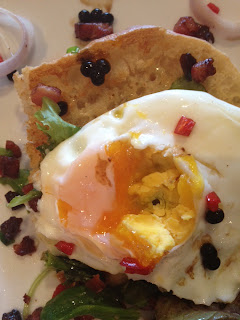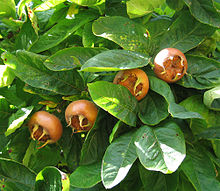My daughter loves visiting Holland to see her grandparents, and had a particularly wonderful time back when the Icelandic Volcano ash caused her to be stranded there for the best part of a month. Her aunts and cousins made her very welcome, as she and her Step-mum, dad and little sister room-hopped the month away. She discovered Dutch food, how the Indonesian connection touched the Dutch palate, and waxes lyrical about stroopwafels and Nasi Goreng. She is also keen on her grandfathers and fathers fondness for smoked eel. I'm guessing the schnapps they quaff makes it slightly more palatable but this not what persuaded her. What she loved the most though, on her last trip, were Bitterballen.
Literally 'bitter balls'. This doesn't mean they taste bitter - rather, they traditionally are served as a snack with the Dutch aperitif Jenever. The daughter, however, merely ate them as a snack. She has begged and begged me to make them, but as I have never tried them, I didn't really know what I was doing. However, I am not one to be deterred by something as minor as never having tried them, so I started to trawl the interwebs, and this is what I came up with.
Essentially, you make a thick roux, as you do with other types of European croquettes; in this instance I made it with beef stock, and a dash of cream but traditionally it's a beef ragout. I also mixed in some cooked mince, and a small amount of Red Leicester cheese - not authentic, and you can't actually discern the cheese, but bloody good nonetheless - it adds a depth. Savoury is the watchword here - spices used were nutmeg, white pepper and celery salt. This is about deep brown flavours! Mix the meat into the roux and allow to set in the fridge overnight. You will then be rolling them into walnut sized balls, anointing them with egg, ensconsing them in breadcrumbs and frying them until golden and crispy. Before serving, allow to cool slightly or else you will take the roof of your mouth off. The combination of hot crispy coating and smooth, luscious, deeply savoury and slightly runny centre is second to none. They know what they are doing, them Dutchies! The daughter tells me that if you roll them into sausages, not balls, they become kroketten! So two recipes for the price of one!
Daughter tells me they are meatier than the Dutch creation, and that this is no bad thing. I may not have got it spot on, but they were pretty damned tasty anyway! I recommend eating them with salad, and some lovely sweet mustard from the Netherlands, Sweden or Germany, as we did. Make more than you need, too - they freeze brilliantly!
Update: I found this unfinished post from 2012 after digging around in my digital bottom drawer and realised I never published it. Earlier this year, I finally visited Holland. It was not the occasion I had wanted to visit for. My daughters grandfather passed away.
I found myself spending a week grappling with the passport office and my local MPs office trying to make sure my daughter could say goodbye. Her grandfather was a very special man. Despite the fact my daughters father and I had long since parted ways, her grandfather made sure to call every birthday or special occasion, not just for my daughter, but for me too. He often spoke to my mother, and always remembered to give his regards to my brother and his family.
At the end of last year, we heard he'd had a few falls. His wife of many years - the only 'grandmother' my daughter and her stepsister on her fathers side, took ill and passed away. Her grandfather said he no longer wanted to go on without her. Sure enough, not two months later, he died. He got to see his son, daughter-in-law and grandchildren one last time, and his son had seen him the day he went. As is typical of such a stoic man who'd survived years in a Japanese POW camp and has rarely mentioned this hardship, he chose a time to go when he was least likely to cause upset, and took his final breath when he was by himself. He'd passed on his story to my daughter shortly before his death and had asked her to remember it, and share it.
My aunt, my late fathers sister, had died the same week, and I was due to attend her funeral with my mother. I felt torn. I'd not spoken to my aunt since my fathers funeral several years before - not maliciously, things had just...drifted, I guess. My Mum needed me to support her, but my daughter also needed me. It was a wretched situation.
In the end, I did what most parents would do and decided to support my child knowing that my Aunt, who has five children of her own, would understand as a mother.
Going to attend the funeral of the father of my ex was a difficult thing to do. But they had come to my Dads funeral, and I felt it was the very least I could do, and I very much wanted to pay my respects.
My daughters father was already in Holland with his cousins (again, it was almost as though his father had planned everything to coincide with his sons visit for everyone's convenience), and we coordinated our flights to land at the same time as my daughters stepmum. We all travelled to the residential home/hotel and I met the cousins and aunts, who I had heard so much about for so many years, and they were lovely. It was an unusual situation to say the least. But my daughters father & stepmother did not make me feel alienated at all. Quite the opposite. I took part as part of the family group. I'm sure primarily to support my daughter, but at what were extremely emotional moments, I was included. In Holland, the family screws the coffin lid on which to me is a very private moment. I made my excuses as the group were led into the chapel of rest, but my daughters father said 'No way. You're coming in.' His wife was equally insistent and I felt deeply moved that, despite the situation, we all came together as a family of sorts. After the ceremony, the immediate family were asked to stay behind and say goodbye and again I was included in this group. And although I felt strange, I didn't feel out of place. This was a man who had, despite the distance, been very much a part of my life. He'd made more effort with me and my daughter than my own grandfather had ever done, and that means something. We may have only been bonded by the fact I carried part of his DNA for nine months, but that didn't matter. People say you can't choose your family. This is true. But you can choose the depth of bond you have with that family. Like any relationship, that takes effort. But the rewards are far-reaching. I felt a bond that goes further than just being acquainted. I met people I may never meet again. People who know full well how strange a situation it was for me to be present, but everyone was accepting. We all knew we were there to celebrate the life of an extraordinary man, who has left an indelible mark on the life of so many, including myself and my daughter. I'm so grateful I had the chance to say my goodbyes.
The day before the funeral, I finally got to try bitterballen with my Dutch and Irish 'family' around me.
I can confirm, my version was pretty darn close and I think I've done justice to my daughters Dutch heritage despite the addition of Red Leicester, but I think the genius and success of the Dutch and British Union is a true metaphor for my family.
Selamat jalan, Cris.








.JPG)






















